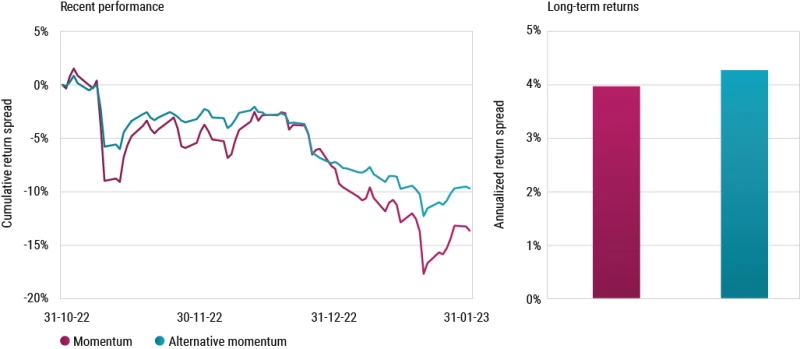Price momentum refers to the tendency for assets that have outperformed or underperformed over a recent period to continue following the same trend in the future. Despite generating strong long-term returns, this approach can also experience significant drawdowns. These ‘momentum crashes’ often occur after bear markets and coincide with rebounding markets. The recent drawdowns in November 2022 as well as January and February 2023 are prime examples of this phenomenon, as illustrated in Figure 1.
Figure 1 | Recent performance and long-term returns for momentum strategies

Source: I/B/E/S, Refinitiv, Robeco. The figure displays the return spread between the top and bottom quintile portfolios based on price momentum and an alternative momentum composite. The price momentum is calculated as the 12-1 month price return, while the alternative momentum composite includes 12-1 month residual momentum, 3-month EPS FY1 revision signals, and 6-month news sentiment data. The investment universe consists of MSCI Developed Index constituents. The portfolios are equally weighted, rebalanced monthly and constructed in a region and sector neutral manner. The left and right charts illustrate the results for the sample period of 31 October 2022 to 14 February 2023, and January 2001 to January 2023, respectively.
Discover the value of quant
Subscribe for cutting-edge quant strategies and insights.
During this period, hopes for an end to monetary tightening and a potential soft landing for the US economy were driven by lower-than-expected inflation numbers and a less hawkish US Federal Reserve. This resulted in the revival of the worst-performing assets from the previous year and negative returns for the momentum factor, while deep value factors did well.1
Our research, however, shows that alternative definitions of momentum – such as residual momentum2, analyst forecast revisions and news sentiment3 – can mitigate these momentum crashes without sacrificing long-term returns. As shown in the left-hand side chart of Figure 1, these alternative definitions of momentum did suffer less during these recent episodes.
The question that remains is whether investors must forgo long-term returns to reduce crash risk, or put differently, whether the momentum premium is a reward for exposure to crash risk. The simple answer is no, as depicted by the right-hand side chart of Figure 1. In fact, we observe that the alternative momentum composite actually exhibits slightly higher long-term returns.
In conclusion, while price momentum is pervasive and can play an excellent role as a diversifying factor when paired with value strategies, its susceptibility to occasional momentum crashes should not be overlooked. On the other hand, alternative definitions of momentum such as residual momentum, analyst forecast revisions and news sentiment offer a solution by providing similar long-term returns, with lower volatility and milder crashes.
Footnotes
1 Tsekova, D. and Lee, J., February 2023, “Quant funds shed billions as Wall Street’s hottest trends falter”, Bloomberg.
2 Blitz, D., Huij, J., and Martens, M., June 2011, “Residual momentum”, Journal of Empirical Finance.
3 Marchesini, T., and Swinkels, L., July 2019, “Integrating news sentiment in quant equity strategies”, Robeco article.
Quant Charts
Important information
The contents of this document have not been reviewed by the Securities and Futures Commission ("SFC") in Hong Kong. If you are in any doubt about any of the contents of this document, you should obtain independent professional advice. This document has been distributed by Robeco Hong Kong Limited (‘Robeco’). Robeco is regulated by the SFC in Hong Kong. This document has been prepared on a confidential basis solely for the recipient and is for information purposes only. Any reproduction or distribution of this documentation, in whole or in part, or the disclosure of its contents, without the prior written consent of Robeco, is prohibited. By accepting this documentation, the recipient agrees to the foregoing This document is intended to provide the reader with information on Robeco’s specific capabilities, but does not constitute a recommendation to buy or sell certain securities or investment products. Investment decisions should only be based on the relevant prospectus and on thorough financial, fiscal and legal advice. Please refer to the relevant offering documents for details including the risk factors before making any investment decisions. The contents of this document are based upon sources of information believed to be reliable. This document is not intended for distribution to or use by any person or entity in any jurisdiction or country where such distribution or use would be contrary to local law or regulation. Investment Involves risks. Historical returns are provided for illustrative purposes only and do not necessarily reflect Robeco’s expectations for the future. The value of your investments may fluctuate. Past performance is no indication of current or future performance.




















